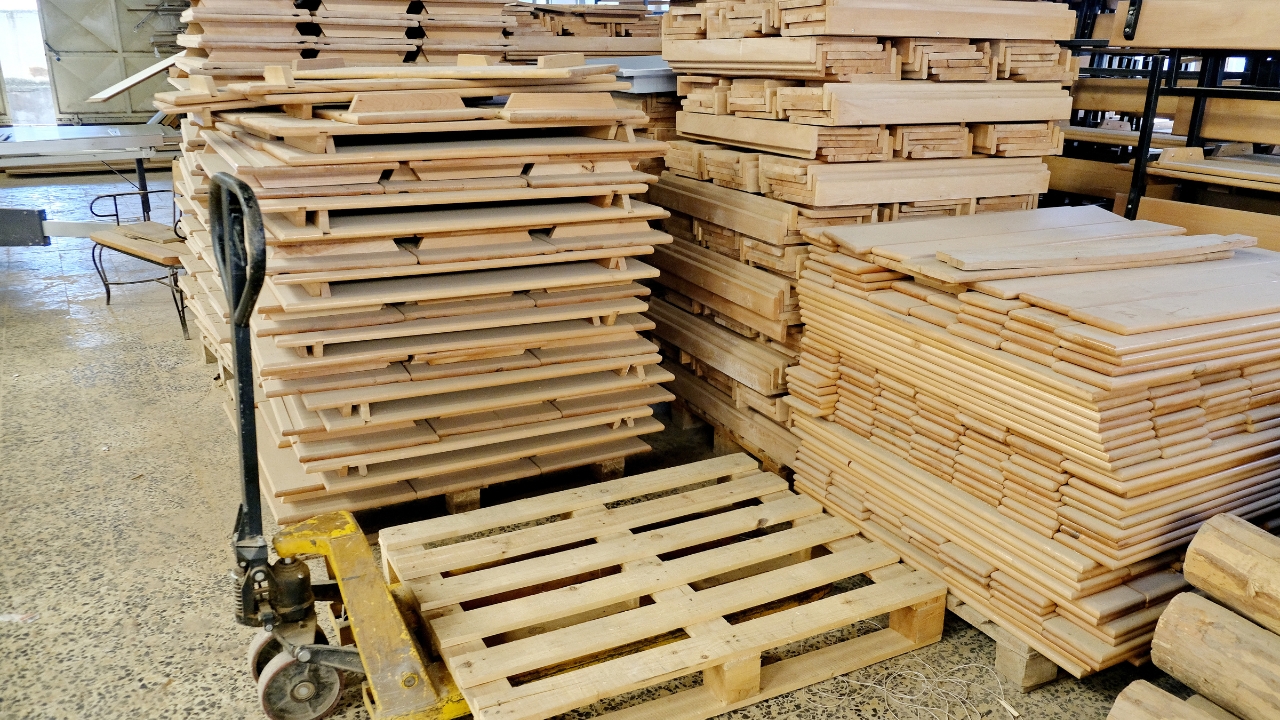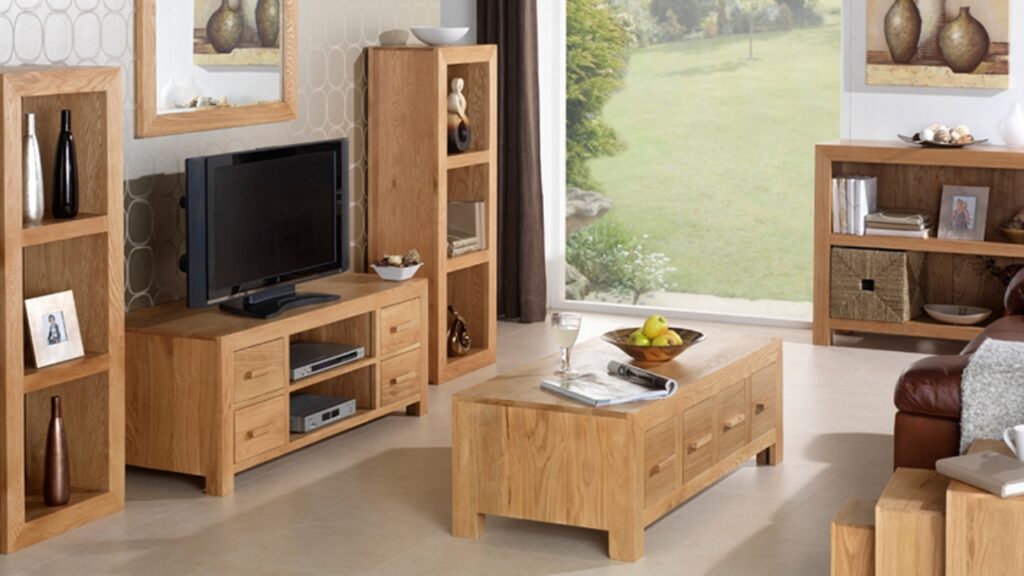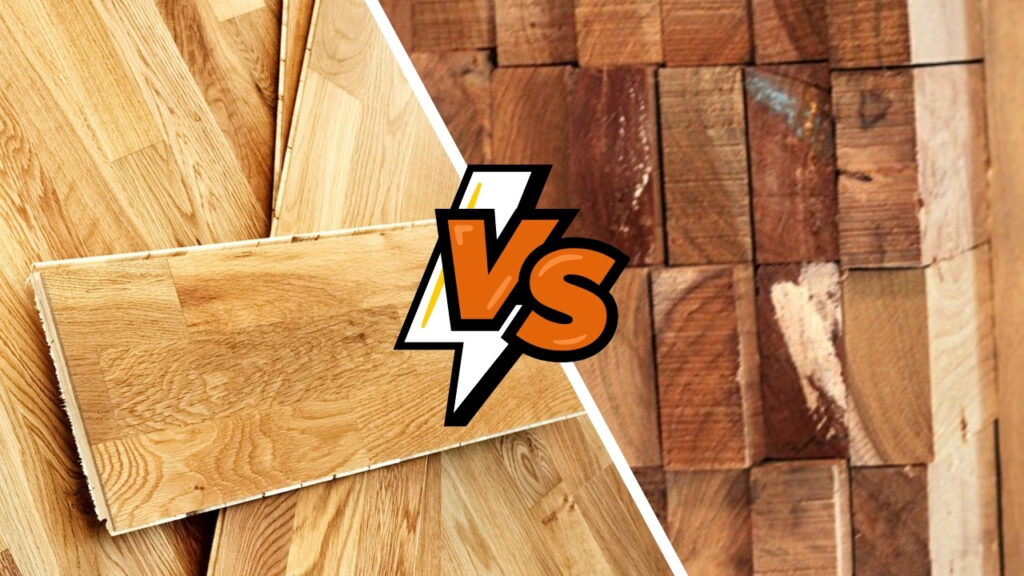What Is Engineered Wood Furniture? Complete Guide

You must have heard about engineered wood if you have shopped for wooden items like cabinets, beds, or desks. Now the question is, what is engineered wood furniture?
Simply put, engineered wood furniture is made of man-made wood manufactured in the factory. This type of wood is very different from solid wood.
For those unversed, engineered wood is made by binding wood fibres, particles, strands, scraps of byproducts and lumber, sawdust, thin wood boards, or veneers with adhesives under high temperature and pressure. It is also known as composite wood and is much cheaper than solid wood.
Engineered wood furniture has recently become highly popular, mainly because of the benefits involved. This wood is not only lighter but also much more affordable. This makes it an ideal choice for those who want to purchase wooden furniture but have a tight budget.
In this guide, we will tell you about engineered wood furniture and other details you must know about it.
What Is Engineered Wood Furniture?
Engineered wood, also known as composite wood or man-made wood, is manufactured in factories by bonding various wood components like wood fibres, veneers, strands, sawdust, or particles. These components are glued together using strong adhesives under high temperatures and pressure to form a strong bond.
This process creates a material that mimics the strength and appearance of solid wood but offers additional benefits like improved durability, stability, and cost-effectiveness.
Engineered wood was initially created as an alternative to solid wood. In recent years, it has gained immense popularity for its affordability and environmental sustainability. Since it uses wood leftovers and byproducts, engineered wood uses raw materials better. This way, it reduces the need to harvest new timber.
Now that you know engineered wood furniture, let us investigate further.
Popular Types Of Engineered Wood

There are different types of engineered wood available. It is good to know the types of engineered wood so you can make the right choice.
Plywood
Plywood is made by glueing together thin layers of wood placed in alternating grain patterns. This increases the strength and resistance to warping. This type of engineered wood is commonly used for construction, furniture, and flooring.
Medium-Density Fibreboard (MDF)
MDF is created by breaking down wood fibres and bonding them with resin under heat and pressure. It has a smooth surface, which makes it suitable for furniture and cabinetry. However, MDF is heavier and less resistant to moisture than plywood.
Particleboard
Particleboard is made from wood chips, sawdust, and resin. It’s lightweight and affordable but lacks the strength of plywood or MDF. It’s often used in low-cost furniture and underlayers for countertops.
Oriented Strand Board (OSB)
OSB is composed of wood strands arranged in layers and bonded with adhesives. It’s used mainly in construction for walls, flooring, and roofing. OSB is cheaper than plywood but offers similar strength for structural applications.
Laminated Veneer Lumber (LVL)
LVL is a high-strength engineered wood product that bonds thin wood veneers together. It’s used in structural beams and supports, providing better load-bearing capabilities.
What Are The Applications Of Engineered Wood?
Engineered wood is a versatile and durable material that has found a wide range of applications in both indoor and outdoor environments. Its ability to mimic solid wood while offering additional benefits like strength, moisture resistance, and affordability makes it popular across industries. Here are some typical applications of engineered wood:
Modular Kitchen
Engineered wood is widely used in modular kitchen designs due to its durability and aesthetic appeal. Everything can be made using engineered wood, from cabinets to countertops and shelving. Not only that but they can also be customized to fit specific spaces and styles. The smooth surface of engineered wood allows for easy cleaning, making it ideal for kitchen environments.
Doors, Wardrobes, and Bookshelves
Engineered wood is commonly used to produce doors, wardrobes, and bookshelves. Its ability to be shaped in various styles allows for different design possibilities. Additionally, engineered wood products can match solid wood in appearance while being more cost-effective.
Laundry Rooms and Bathrooms
Engineered wood is an excellent choice for laundry and bathroom furniture, such as cabinets, shelves, and vanities. Its resistance to moisture makes it suitable for high-humidity areas like bathrooms, ensuring longevity and maintaining structural integrity over time.
Flooring Solutions
Engineered wood flooring combines hardwood’s natural beauty with engineered materials’ stability. The good thing about this wood is that it is less prone to warping and can be installed in various environments, including basements and over concrete slabs.
Soundproofing and Insulation
You can also use engineered wood for soundproofing and insulation in walls and ceilings. Their density helps absorb sound, making them useful in residential and commercial applications.
Internal Panelling and Structural Applications
In construction, engineered wood is often used for internal panelling and structural elements like joists and beams. Products such as plywood and laminated veneer lumber (LVL) provide strength and stability, making them suitable for residential and commercial buildings.
Outdoor Furniture
Engineered wood is also used to create outdoor furniture like lawn chairs, tables, and swings. Its ability to withstand weather conditions, especially when treated with appropriate finishes, makes it a popular choice for patio and garden furniture.
Advantages Of Engineered Wood
As we mentioned before, engineered wood offers several advantages. Before you get engineered wood furniture for your home or office, consider the benefits involved.
Varied Options Available
Engineered wood comes in various thicknesses, grades, and sizes, making it adaptable to different design styles and rooms. This allows it to meet multiple application-specific requirements with ease.
Durable and Long-lasting
High-quality engineered wood is designed to last, ensuring the furniture has a long service life. This makes it a preferred choice for furniture and construction.
Cost-Effective
Engineered wood is comparatively less expensive than solid wood. This makes it a budget-friendly choice for many homeowners and builders.
Smooth Surface
Most engineered woods have a flat surface without knots, allowing for easy application of stains, polishes, and paints. This means you can get an excellent finish on the wood surface.
Easy to Maintain
With laminated surfaces, engineered wood furniture is more accessible to care for and clean. This makes it a convenient choice for everyday use.
No Warping
Thanks to its multi-layer core, engineered wood resists warping, expansion, and discolouration when exposed to moisture or temperature changes. So, if you want a more stable material, engineered wood is for you.
Aesthetic Appeal
Engineered wood can look like solid wood, providing an attractive, natural appearance at a lower cost.
Rot and termite-resistant
When treated with the right chemicals, engineered wood can become resistant to termites, rot, and borers. This way, you can extend the lifespan of your engineered wood furniture in areas prone to these issues.
Customization
Engineered wood is highly flexible, which makes cutting, drilling, and fastening easier. In other words, you can customize it the way you like.
Environmentally Friendly
Engineered wood is often made from recycled wood or scraps from other lumber products. This reduces the need for additional tree logging, which benefits the environment.
Lightweight
Furniture made from engineered wood is lighter than solid wood, making it easier to move, shift, or transport without much effort.
Disadvantages Of Engineered Wood
Despite all the good things, engineered wood has some drawbacks that you should know about. We have provided the details in the lines below.
Weight Issues
Some types of engineered wood can be heavy and dense. This makes it difficult for designers to work with them.
Edge Finishing
Materials like plywood often show layers of veneers at the edges, which require additional finishing with veneer or laminate to create a polished look.
Toxicity Concerns
The manufacturing process often involves urea-formaldehyde resin, which can be toxic and negatively impact indoor air quality.
Limited Strength
Although engineered wood is strong, it may have a different load-bearing capacity than solid wood in some applications.
Moisture Vulnerability
Certain types, such as particle boards, have a low resistance to moisture and humidity, which can lead to expansion, warping, and discolouration over time.
Water Absorption
Medium Density Fibreboard (MDF) is not water-resistant. This means it is prone to swelling and damage if it absorbs moisture.
Price Of Engineered Wood
So, what is the price of engineered wood furniture? This is the first thing that will cross your mind when buying new pieces for your home. Here’s a breakdown for you.
Particle Board (Rs 20 to Rs 50 per sq ft)
This is one of the cheapest options for engineered wood.
High-density fibreboard (Rs 50 to Rs 170 per sq ft)
High-density fibreboard (HDF) is a more robust and denser version of engineered wood, and its price depends on thickness and quality.
Medium-density fibreboard (Rs 50 to Rs 190 per sq ft)
Medium-density fibreboard (MDF) is more expensive than particleboard but provides a smoother surface for finishing.
Wooden Laminate Sheets (Rs 75 to Rs 200 per sq ft)
The price of wooden laminates varies based on thickness, design, and quality.
Blockboard (Rs 80 to Rs 210 per sq ft)
Blockboards are stronger than MDF and particle boards. The price range depends on thickness and quality.
Engineered Wood vs Solid Wood: Which One To Choose?

Understanding the differences between engineered wood and solid wood is essential before deciding. Both materials have their pros and cons, which can influence your decision. Here’s a detailed comparison:
Longevity
When investing in furniture, it’s essential to think long-term. Solid wood is an excellent choice if you want durability that can last for generations. On the other hand, engineered wood is less durable. However, it is less likely to warp under extreme conditions.
Usefulness
Both solid and engineered wood are versatile, but their uses differ. Solid wood is often preferred for hardwood flooring and high-end furniture, whereas engineered wood is used in areas with high humidity, like basements or garages.
Budget Friendliness
Solid wood is not the best option if you are on a tight budget as it is more expensive. Engineered wood is more affordable and also offers a variety of styles and designs to choose from.
Ease of Installation
Solid wood is heavier, which makes installation more labour-intensive. Engineered wood is the better choice if you want something quick and easy to install.
Final Words
By now, you should know what is engineered wood furniture and whether you should get it for your home. It offers a budget-friendly and versatile option for stylish and functional pieces. While it may not match the strength and longevity of solid wood, its lightweight nature makes it a popular choice.
FAQs
Is engineered wood good quality for furniture?
Engineered wood can be of good quality for furniture. However, its quality depends on the type and how it is treated.
Is engineered wood better than teak wood?
Engineered wood is less expensive and lighter than teak wood, making it a popular choice for budget-friendly furniture. However, teak wood is much more durable and resistant to water and pests.
Which is better, natural wood or engineered wood?
Natural wood is considered superior in terms of longevity, appearance, and strength. Engineered wood, on the other hand, is more affordable and versatile.
What are the negatives of engineered wood?
Engineered wood is less durable than solid wood. Plus, it can be prone to moisture damage.
Which is better, Sheesham or engineered wood?
Sheesham is better than engineered wood due to its natural strength, durability, and rich appearance.

